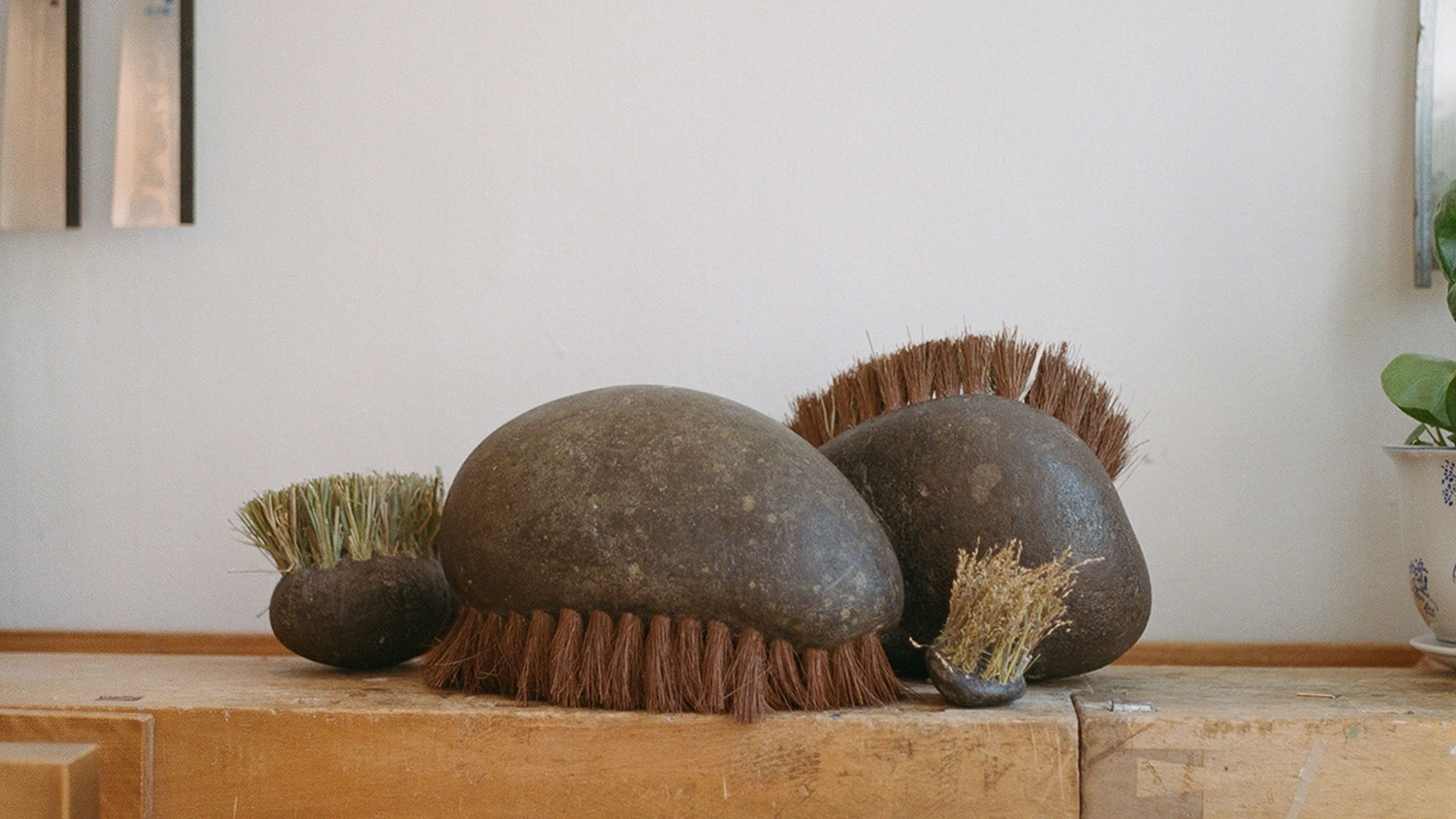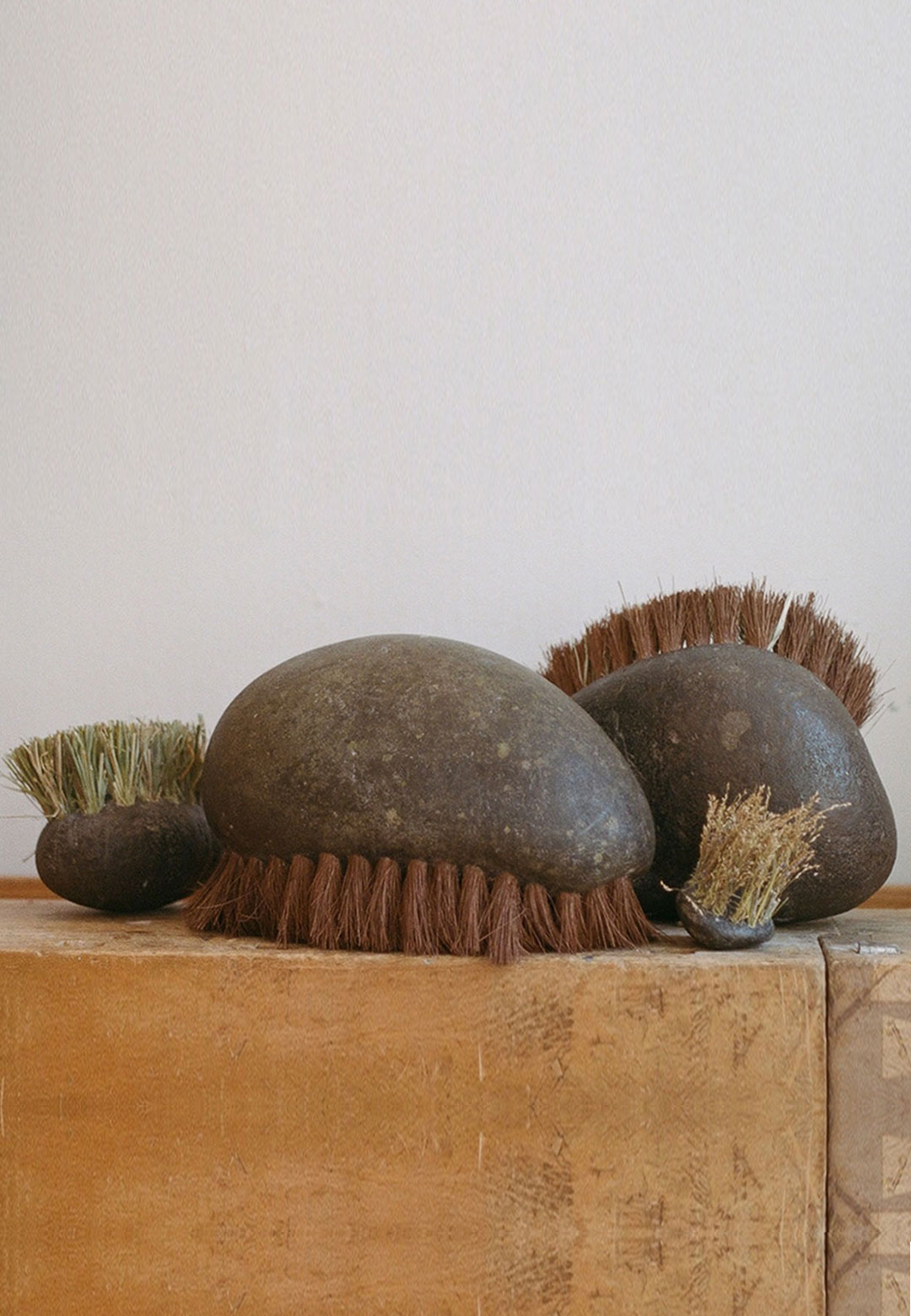Interventions undertaken for the purpose of upgrading tools and gadgets to enhance convenience often ensue at the expense of aesthetics and sentimental value. Hence, our homes and offices are dotted with electronic gadgets, electrical appliances, and other industrial design tools and entities that are defined by metal and glass bodies, monochrome hues, and minimalist geometries. One can spot the influence of this aesthetic in objects built for daily chores as well. Challenging the notion of the industrial aesthetics associated with objects built for domestic chores, New York City-based product designer Thomas Bjorn Pozza Yang and ceramicist, printmaker, animator, and fiber artist Makiah Roberts designed the Stone Brush, an object meant to transform the mundane task of sweeping the floor into a spiritual event.
Roberts and Yang's collaboration emerged from their common interest in finding ways to narrate stories. “My practice is centered around making objects that tell stories, and ask questions,” Yang shared. “How are objects used as props in the stories of life? How does the object transform the mundane into something magical? Can turning on the faucet become a poem of respect and gratitude to the reservoir from which it flows? The stone brush is one of many projects that embodies my philosophy of design, through material and craft ideologies, as well as the philosophical inquiry that seeks to understand what it means to create an object for cleaning. Handmade objects reveal their beauty as they age into artefacts and become aware of the death inherent in living,” the American designer adds.
Makiah Roberts, a multidisciplinary artist and designer who explores the subjects of escapism, consciousness, and ecology, and is driven by the urge to utilise archival materials in her work, asserted, “I create objects in honour of the stone that you keep in your pocket to hold when you walk, the smooth chestnut that you bring home from the park, and the spare button that you keep tucked away in a biscuit tin. Our Stone Brushes ask: what do you keep close to you? What textures and sensations comfort you?”
Further delineating the inspiration behind the design of Stone Brush, Yang and Roberts share, “Stone Brush stems from the inquiry that explores what it means to clean and what the imposed authority of an object that has a role in defining the methodologies of cleaning is.” Constructed using natural materials, the brush intends to help the user rekindle the inherent connection humans share with the earth and its entities. In doing so, it also manages to question the prescribed ideologies associated with utilitarian cleaning and domestic objects. Enunciating on the object’s intention, the collaborators share, “Furniture and objects aim to have lightness; can there be an object that is sought for its weight, its material connection to the natural environment, and through its medium act as a form of healing the mind and soul? Can the object's weight inform the body’s meditation through its movement?”
Although the foremost feature one looks for in a broom is lightness, Stone Brush, with its atypical heaviness, guides the user’s movement through its weight. This intrinsic and subtle mode of instructional movement transforms the act of sweeping floors from a chore to a meditative activity.
In using raw materials from their locale, Yang and Roberts managed to root and link the object to the environment of New York, making it suitable for accreditation under vernacular. The bristles of the brush were made using plants and weeds foraging from around the city. A few natural entities used to weave the bristles include Palm fibre, Russian Sage found near Rockaway Beach in Queens, and goosegrass found in the New York area. The salvaged entities were then dried, folded, wrapped into bundles, and inserted into the hole drilled in the stone filled with hot beeswax. The stones for the brush, on the other hand, were acquired from the nearby Trout Brook, which runs through the ancestral land of the Lenape people. Additionally, beeswax acquired from the Union Square Market in New York was used to bind the two entities.
“The primary prototype of the brush was to explore the methodologies of fastening the bristles to the stone without using any chemically based binder. The final forms of the stones seek to have a connection with the hand, and focus on how the hand could fall naturally around the stone in comfort,” the designers shared with STIR. The stones used to build the Stone Brushes were not chiselled or cut. The natural form of each stone was retained, with holes drilled on one face of each stone in order to affix the bristles. The stones sized and shaped differently, guide the user’s hand differently. Explaining the technical procedure undertaken to meld the stones with the bristles, the designers shared, “The process of drilling required a diamond drill bit and water. Due to the irregularity in the form of the stone a drilling vice was constructed out of wood to hold the rock level to the drill press. Each hole has drilled a minimum of ½ inches deep to ensure stability in the bristles attachment.” Another element that forms part of the Stone Brush project is a clear mat made out of reclaimed wood. It frames the space meant to be cleaned and helps the user focus on a designated area as opposed to an entire room.
On being asked what NEXT is in store for the duo, both Yang and Roberts share that they intend to explore similar projects pivoted on encapsulating philosophical ideas and artefacts found objects.






 Sign in with email
Sign in with email








What do you think?